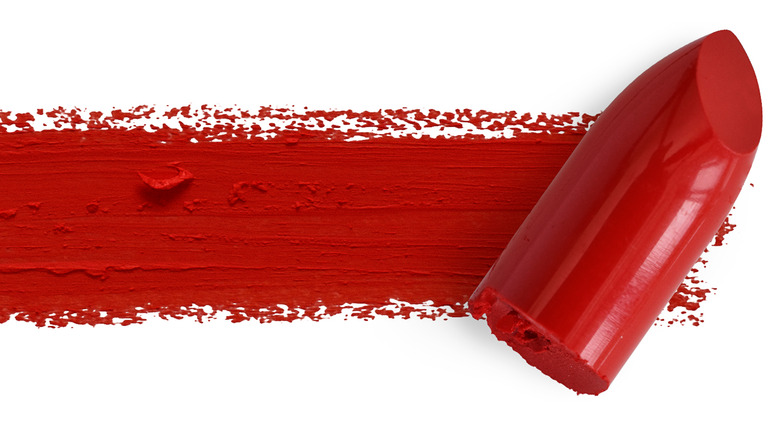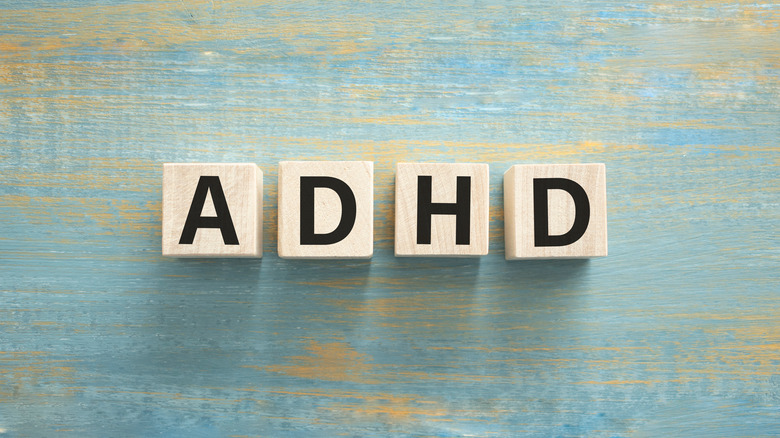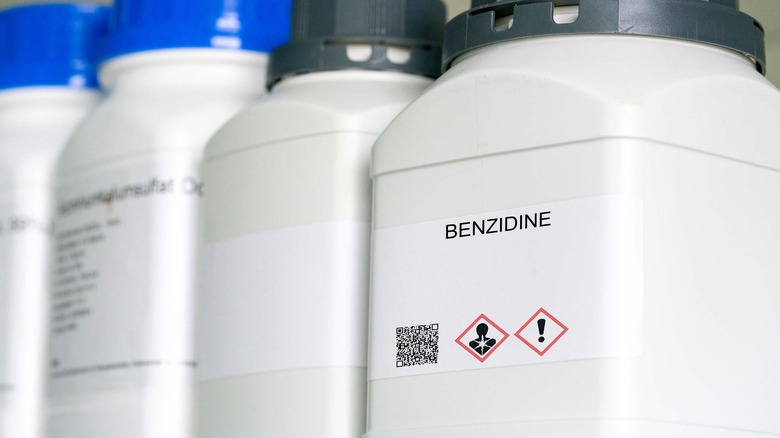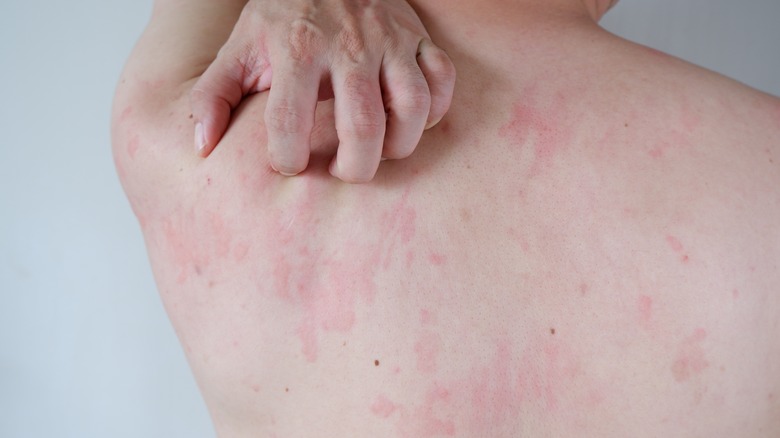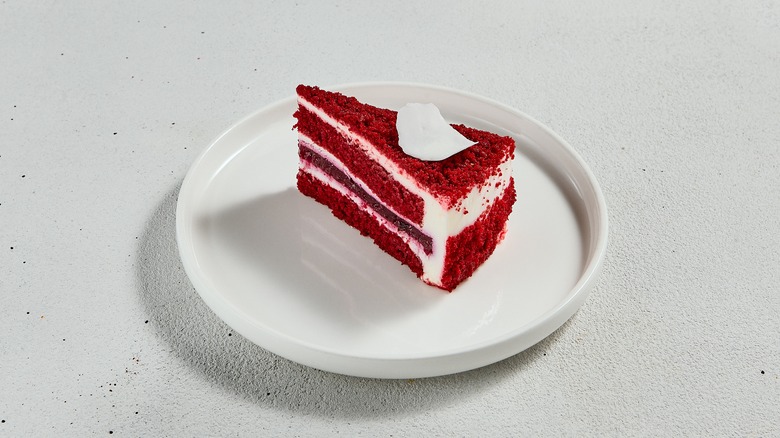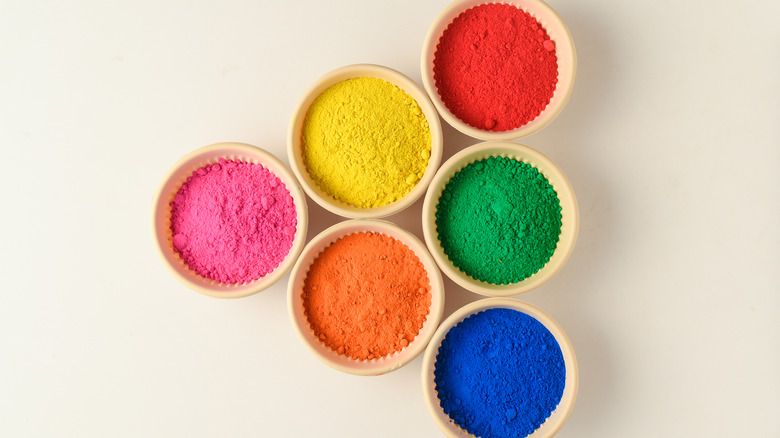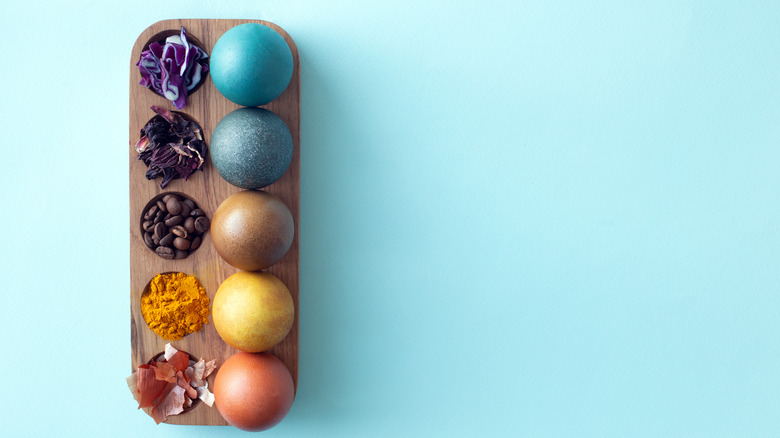The Reality Of Red Dye 40
If you have ever looked at a food label on a processed food that is brightly colored, chances are you've run across the words "Red Dye 40" among other additives like Blue No. 1 or Yellow No. 5. All of these are food dyes (per GoodRx Health). Like the other dyes mentioned, Red Dye 40 is a type of artificial coloring that is often added to processed foods, beverages, medications, and other products (cosmetics come to mind) to brighten or enhance their natural colors. It is currently one of nine FDA-approved synthetic color additives.
If you're wondering how Red Dye 40 is made, you might be surprised to learn that historically all color additives were actually gleaned from coal. Today, they typically start from a base of crude oil or petroleum, which are fossil fuels. Of course, that doesn't sound healthy, but it's important to remember that this is only the base ingredient. By the time they are fully processed and added into consumable products, the dyes don't contain any leftover petroleum. Despite this assurance, many people remain concerned about the short and long-term health effects of food dyes like Red Dye 40.
According to WebMD, Red Dye 40 is used to create distinct colors that are often described as fun or eye-catching to consumers, such as in drinks, cake mixes, and frostings. A bright red color may also lend the connotation (to a consumer) of certain flavors like cherry or strawberry. It may even be blended with other dyes to form the colors purple and orange.
In this article, we will explore the evidence behind what health concerns (if any) Red Dye 40 presents, its safety profile, as well as some natural alternatives for those who are concerned about Red Dye 40 consumption.
Red Dye 40 safety
The million dollar question: Is Red Dye 40 safe? The answer depends on who you ask and what research you consult. According to Healthline, the EPA (Environmental Protection Agency) views Red Dye 40 as a "low concern." The acceptable daily intake (ADI) for Red Dye 40 is 3.2 milligrams per pound of body weight, which corresponds to the amount of an additive that can be consumed daily without causing harm. Most Americans consume far less than this.
Despite this assurance, many people remain skeptical about the safety of food dyes like Red Dye 40 for reasons we will soon explore such as allergies, a link with ADHD, and other health concerns presented in research (per Livestrong) and published in Nutrition Review. For this reason, several well-known companies have opted to remove the dye from their products. For instance, the popular cereal company General Mills announced it would be removing all synthetic coloring from its cereal products, opting for natural color options like fruit and vegetable juices instead. Kraft even swapped its iconic yellow 5 and 6 food coloring for natural colorants like turmeric and paprika from its popular macaroni and cheese product. This came after mounting pressure (the same year) from vocal food activists and a change.org petition that received more than 365,000 signatures demanding removal of the synthetic colorings, according to a CBS News report.
It may trigger migraine headaches
One popular concern about Red dye 40 is its link with allergies, migraine, and allergy-linked migraine (per Healthline). Since allergies can result from any substance, benign or harmful, that the body views as foreign and a potential threat, food components like synthetic dyes also fall under this category. Although we commonly associate allergies with symptoms like runny nose or watery eyes — and in more severe cases trouble breathing and rashes — allergies have also been known to trigger migraine headaches in some people. This type of headache is more intense and can cause a stabbing pain that may last hours or even days. Although there is not much clinical research to support this, many people anecdotally report having a sensitivity to foods containing red and other dyes, so it is something to consider if you experience migraines after consuming artificially colored foods.
You can also consider taking a food challenge if you suspect Red Dye 40 may be triggering headaches or other allergic reactions. During a food challenge, your healthcare provider or allergist will give you a capsule containing a particular food ingredient — some containing the suspected allergen — but you will not know which pill contains the allergen. After taking the pill, you'll be observed for signs of allergic reactions (such as headache) to confirm or rule out the suspected allergy. If you are interested in undergoing a food challenge, speak with your healthcare provider.
It may exacerbate ADHD in children
Perhaps the health issue generating the most debate is the long-time concern about an association between Red Dye 40 and ADHD (Attention Deficit Hyperactivity Disorder) in children, according to Healthline. Red Dye 40 has been associated with aggressive behavioral issues and inattentiveness in children. ADHD itself causes inattentiveness and is marked by trouble focusing and keeping attention to tasks — as well as restlessness, fidgeting, and inappropriate outbursts of aggression and anger. The FDA even states that although most children do not experience these negative behavioral effects from Red Dye 40-containing foods, there is evidence to suggest some children may be extra sensitive to it.
This is further backed by a 2012 meta-analysis from the Journal of the American Academy of Child and Adolescent Psychiatry which reviewed 34 studies on children with ADHD spanning the United States, U.K., Australia, and Canada. The reviews indicated that as many as 8% of children may experience behavioral symptoms from artificial food coloring. The same review shows significant improvement of ADHD symptoms in children who restricted their synthetic food dye consumption but was careful to note that these results may be subject to publication bias, so further research is needed.
That doesn't mean these results are irrelevant, given there are mechanisms to explain the behavioral improvements following food dye restriction. According to both Livestrong and Healthline, Red Dye 40 is linked to behavioral hallmarks of ADHD in children like impulsivity and hyperactivity due to the chemical changes it imposes directly on the brain, per a 2013 review in Nutrition Review. These changes include inflammation related to allergic reaction and depletion of important minerals like zinc involved in brain development and function. This is understandably concerning — particularly for parents.
It may reduce attention and increase irritability
Along with the purported link of ADHD to synthetic food dyes like Red Dye 40, the dye has also been associated with specific ADHD symptoms like reduced attention and focus, according to Additude. Joel Nigg, director of the ADHD Research Program at Oregon Health and Science University, along with American Academy of Pediatrics, are calling out the FDA to either ban synthetic dyes altogether or require manufacturers to put a warning label on their products warning of hyperactivity side effects from synthetic dyes. He says, "The FDA considered the issue in 2011 and again briefly in 2019, but opted not to take action. Since 2011, several new literature reviews have converged supporting the conclusion that food dyes increase the risk of ADHD symptoms."
He further states that even children without ADHD can be negatively affected by synthetic food dyes but that children with ADHD are especially sensitive to them. Along with inattention, aggression and irritability are other undesirable side effects. Dr. Nigg states, "There is some secondary evidence of effects on irritability, but most studies did not look at this formally. Food dyes probably make children with and without ADHD more irritable. However, in most cases, ADHD is an accumulation of multiple risk factors."
A 2007 study on children with ADHD and ADD out of the University of Southampton and published in The Lancet showed that children who consumed a combination of common food dyes displayed more hyperactivity symptoms only an hour after consuming. The study was so compelling that Britain's Food Standards Agency strongly encouraged manufacturers to look for alternatives to food dyes following release of the results.
The link with synthetic food dyes and ADHD, inattention, and irritability seems quite clear from this research.
It may be carcinogenic
Perhaps of most concern for health experts and consumers alike as it pertains to food dye safety is the risk for cancer. But is there any evidence to support such concern? There might be, according to science writer Ruth Winter who discusses these risks in her book, "A Consumer's Dictionary of Food Additives" (per GoodRx Health). In one portion of her book she states, "The National Cancer Institute reported that p-credine, a chemical used in preparation of Red No. 40, was carcinogenic in animals. In rats, a high (3,800-8,350 mg/kg) oral dose of the coloring caused adverse reproductive effects." Although this amount is not found in commercially-available products, it still makes many people wary of Red Dye 40's safety even in small amounts.
Furthermore, a 2012 review published in the International Journal of Occupational and Environmental Health showed that some food dyes (Red Dye 40, Yellow No. 5, and Yellow No. 6) are often contaminated with carcinogens like benzidine which is connected to an increased risk for bladder cancer, according to GoodRx Health. The review went on to recommend that regulatory agencies require more independent testing for toxicity, be more reluctant to approve dyes, and only approve dyes that are well tested and proven to be safe for future approvals, especially in light of the fact that synthetic dyes do not add any nutritional quality or safety value to foods.
It is also interesting to note that fewer dyes are approved in the EU than in the states, according to Medscape. One must wonder why their requirements are stricter? Even if the colorings themselves don't directly cause cancer, there is evidence that bacteria in the gut may break down the dyes into potentially carcinogenic compounds. For instance, synthetic dyes have shown to increase inflammation, which over an extended period of time can damage cells and their DNA, a known precursor to many cancers.
It may cause allergic reactions
Like other synthetic compounds, it's possible that Red Dye 40 can cause allergies in some people, according to a review by Food Chemistry (via Livestrong). It's often difficult to isolate allergies to Red Dye 40 because foods containing it often have many other additives, but a CSPI report stated that a small number of people can be hypersensitive to the dyes. The same report described some of the allergic reactions associated with Red Dye 40 range from hives to a swollen face. Hyperactivity in children is also thought to indicate a potential allergy to the dye.
You can also consider taking a food challenge if you suspect Red Dye 40 may be triggering an allergic reaction, just as you would for migraines (per Healthline). Recall that migraine headaches are another symptom of an allergic reaction to synthetic dyes. While most allergic reactions are mild and primarily involve the skin, other allergy symptoms such as water eyes or sneezing could also signal a potential allergy to the dye.
If you are looking to limit or eliminate Red Dye 40 consumption due to the concerns such as allergies, you'll want to read the ingredients list on the foods you buy. It's key to remember that Red Dye 40 often goes by other names such as the following: Red 40, Red 40 Lake, Allura Red AC, FD&C Red no. 40 Aluminum Lake, E129, and FD&C Red no. 40 (per Medical News Today).
Common foods with Red Dye 40
It's also helpful to have a handy list of foods and products that contain the dye if you are watching out for them. Since Red Dye 40 is one of the most prevalent color additives, be sure to look for them in foods and drinks like the following: energy and sports drinks, soda, protein powders, dairy products like colored yogurts or ice creams, breakfast cereals — especially colorful cereals like the ones marketed to children — gelatins, and candies (per Medical News Today). Brightly colored medicines and cough syrups are also potential culprits. Other foods that often contain this popular dye include condiments like ketchup or hot sauce, fruit juices and soft drinks, puddings, baked goods like cake or cookie mixes, and fruit snacks and gummies (via GoodRx Health)
In summary, you can see that just about any processed food that is colored could contain Red Dye 40 or other food dyes. Conversely (in nature) usually only fresh fruits, vegetables, and legumes are so intensely colorful.
Ways to decrease Red Dye 40/food dye intake
If you are looking for ways to decrease your Red Dye 40 or synthetic dye intake — along with reading food labels for brightly colored or processed foods that are common culprits of the dye — you can also naturally and effortlessly decrease your intake by eating mostly unprocessed foods which are typically dye-free, explains Healthline. Whole foods that are usually free of any added dyes include: plain milk (not flavored milks like chocolate or strawberry), plain yogurt, real cheese, eggs, fresh poultry, beef, fish, or pork, unflavored nuts or seeds like bulk pecans and walnuts, fresh fruits and vegetables, starchy veggies like sweet potatoes, corn, or red potatoes, whole grains like barley, quinoa, or oats, and legumes, such as black beans, green peas, or red beans. These foods are colorful due to naturally occurring compounds like chlorophyll and beta carotene.
Not only that, but many of these naturally colorful foods confer additional health benefits, such as antioxidative properties that may offer protection from many chronic illnesses ranging from macular degeneration to cancer (per the Almanac). For example, chlorophyl, the pigment that gives plants like broccoli, spinach, and kale their deep green hue, may help to neutralize carcinogens. Carotenoids, a common plant pigment in many orange, yellow, and red plants like tomatoes, sweet potatoes, and squash, may help protect against macular degeneration, cancer, and heart disease. This is why it is so often encouraged to "eat the rainbow."
Dying alternatives to Red Dye 40
If you are looking for some natural ways to brighten your food (cakes and icing, for instance) or make your kids' food more playful, there are many natural alternatives, according to GoodRx Health. The naturally occurring pigments in many brightly-colored plants like beets, cherries, and carrots can be used to create a vibrant red/purple color.
The natural food section of your grocery store will also have natural food coloring, made with "Color additives exempt from batch certification" (per U.S. Food & Drug Administration). These are derived from either plants or minerals, such as fruit juice, carrot oil, caramel, iron oxide, and vegetable juice.
If you're looking for ideas on specific natural coloring products, there are quite a few of them. For instance, the brand Watkins has a product made from vegetable juices and contains no artificial dyes. According to their site, "Watkins food coloring is free from artificial colors and made by nature. Derived from pure vegetable juices and spices including beet juice, turmeric and spirulina extract." You could easily use a food coloring like this the next time you dye eggs or make DIY Play-Doh or modeling clay with your kids in place of regular food coloring. Their website even offers handy tips like how to best dye eggs, blend colors, and tips on preventing color changes during cooking and baking. The brand is also gluten-free.
Kroger's Simple Truth brand also makes a natural food coloring called "Simple Truth Natural Food Color." Their product description states that their food colors are "made from concentrated vegetable colorants and spices that are free from FD&C dyes and corn syrup." WebMD also advises carefully researching fast food joints — as many contain synthetic dyes in their foods and beverage products.

